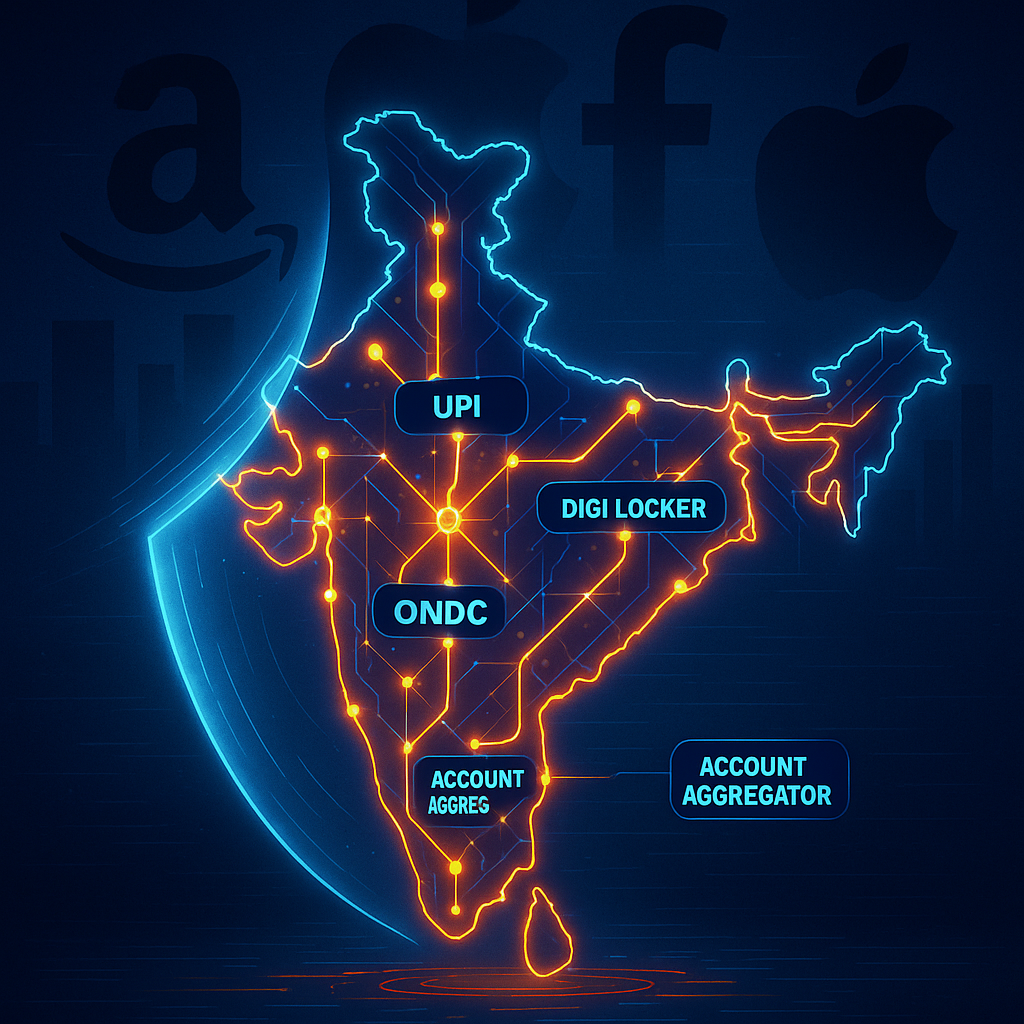
- The India Stack, a group of digital public goods (DPGs) such as Aadhaar, UPI, Digi Locker, ONDC, and the Account Aggregator Framework, forms the backbone of India’s digital sovereignty model.
- UPI has become the most revolutionary component, handling more than 12 billion monthly transactions by 2025, making India the global leader in real-time digital payments.
- India’s strategy of “Digital Atmanirbhar Bharat” emphasises building domestic platforms, supporting local startups, and ensuring critical digital infrastructure remains under Indian regulatory control.
- Despite advancements, the threat of “digital colonialism” persists, with American Big Tech dominating areas like cloud, search, and app ecosystems, creating vulnerabilities in security and economic autonomy.
Introduction
The global economy has entered a stage in the twenty-first century where data, technological ecosystems, and digital infrastructure are just as crucial as physical infrastructure like ports, highways, and energy grids. The ability of a country to independently control and manage its digital resources, platforms, and data flows has become a defining concept known as “digital sovereignty.” This concept is a national priority for India rather than merely an academic one. With more than 1.4 billion people, a thriving digital economy, and one of the world’s fastest-growing startup ecosystems, India’s ability to navigate its digital future will determine its economic course and geopolitical clout.
The India Stack, a group of Digital Public Goods (DPGs) that offer infrastructure for identity, payments, and data sharing, is at the heart of India’s approach. The foundation of this system is represented by Aadhaar, UPI, Digi Locker, and ONDC. India Stack is open, interoperable, and focused on the general public, in contrast to commercial systems created by Big Tech. Because of its success, India is now seen as a global leader in digital innovation in addition to changing the domestic landscape.
Foundations of the India Stack
Instead of being a single product or platform, the India Stack is a comprehensive and layered framework, which makes it unique. Identity, payments, and data sharing are the three fundamental pillars upon which its architecture is built. The fundamental components are:
- Aadhaar: Rolled out in 2009, Aadhaar is the largest biometric-based digital identification system in the world, with more than 1.39 billion enrolments. It facilitates identity authentication for banking, welfare distribution, and digital services.
- UPI (Unified Payments Interface): Introduced in 2016, UPI is perhaps the most revolutionary aspect of the stack. It has grown quickly, dealing with more than 14 billion monthly transactions by 2025, making India the world leader in real-time digital payments.
- Digi Locker: A cloud-based, secure platform through which citizens can store and exchange official documents, minimising the use of paper-based documents.
- ONDC (Open Network for Digital Commerce): Focuses on e-commerce democratisation through the establishment of an open network in which buyers and sellers can trade without being confined to proprietary platforms such as Amazon or Flipkart. It is still in its early rollout stage, with expanding adoption.
- Account Aggregator Framework: A consent-based system enabling individuals to share their financial data across institutions securely.
These tools work together to create a full-stack digital infrastructure that is unmatched in terms of inclusivity and scale. India has created a third model that is publicly governed, interoperable, and scalable, in contrast to China’s state-led ecosystems and the West’s heavy reliance on private platforms.
India promotes its digital public infrastructure globally, with cross-border UPI partnerships (like with Singapore), Aadhaar-like ID projects in Africa, and DPI adoption in countries such as Mauritius and the Philippines.
India’s Quest for Digital Sovereignty
India’s aspirations for digital sovereignty are influenced by both internal and external factors. At home, facilitating economic inclusion, minimising digital divides, and guaranteeing universal access continue to be top priorities. India has to navigate a world where China’s state-backed digital giants and American Big Tech dominate the global scene. Reliance on foreign platforms raises the possibility of “digital colonialism,” in which India loses out on data, economic rents, and strategic advantages.
Often referred to as “Digital Atmanirbhar Bharat,” India’s strategy places a strong emphasis on developing domestic platforms, supporting local startups, and making sure that vital digital infrastructure is still subject to Indian regulatory control. Although it welcomes foreign investment, India is adamant that it cannot rely on multinational firms to handle its digital future.
Economic Impact of Digital Public Infrastructure
One of the main forces behind economic inclusion has been the India Stack. Millions have entered the formal economy as a result of its significant reduction in transaction costs and ease of access to services. By itself, UPI has improved financial transparency and decreased reliance on cash. Digi Locker has saved millions of work hours every year by streamlining procedures in the fields of healthcare, education, and transportation.
Digital public infrastructure is predicted to boost India’s GDP growth by 0.5–1% annually. UPI has greatly benefited startups and small businesses by enabling instant settlement at little or no cost. In order to lessen the duopoly of multinational corporations and provide Indian SMEs with an even playing field, ONDC seeks to emulate UPI’s commercial success.
Risks of Digital Colonialism
The threat of digital colonialism persists in spite of India’s advancements. Online advertising, app ecosystems, and cloud computing are all dominated by American companies. Nearly 95% of India’s search market is controlled by Google, and practically all smartphones are powered by Android. Microsoft Azure and Amazon house vital business data. This over-reliance leads to vulnerabilities in terms of both national security and the economy.
India’s intention to exert more control is reflected in its data localisation laws and antitrust cases against Google and Meta. Making sure that domestic alternatives can grow and compete on a global scale is the difficult part. In the absence of strong domestic leaders in cloud services, AI, and semiconductors, India runs the risk of becoming permanently reliant on outside parties.
Policy Landscape
In order to protect digital sovereignty, India’s policy ecosystem is changing quickly. Among the crucial actions are:
- The Digital Personal Data Protection Act (DPDP Act, 2023) imposes duties on businesses and establishes rights-based data governance.
- RBI’s Data Localisation Norms: Restrict data flight by requiring financial data to be stored in India.
- The National AI Strategy promotes ethical AI development based on Indian requirements.
- DPI Export Strategy: Mauritius (digital ID adoption), Singapore (cross-border UPI–Pay Now payments), and the Philippines (pilot stage for data-sharing frameworks) are already adopting parts of the India Stack, which India is promoting as a model for developing nations.
These regulations strike a delicate balance between safeguarding the public and fostering innovation. Whether India’s regulatory approach can be used as a model by the Global South will be decided in the upcoming years.
Global Collaborations
India has established itself as a preferred international partner due to its leadership in digital public infrastructure. India has promoted digital public goods as a global common within the G20 and BRICS. Important turning points include its partnerships with the UAE on digital identity interoperability and Singapore on cross-border UPI payments. Indian tech companies are helping governments in Africa create identity systems similar to Aadhaar.
Furthermore, the European Union and India are both concerned about the dominance of Big Tech. India’s DPI journey provides a model of cost-effective scalability, while Europe strives for “digital sovereignty” through programs like the European Digital Identity (EUDI Wallet) and Gaia-X cloud initiative. Opportunities for collaborative efforts in cybersecurity, privacy frameworks, and trusted cloud systems are created by this convergence.
The Road Ahead
India is still working on its digital sovereignty project. The nation has to overcome obstacles like the need for digital literacy, infrastructure gaps in rural connectivity, and limited domestic semiconductor capacity. However, there are risks and opportunities associated with emerging fields like Web3, quantum computing, and generative AI.
India should concentrate on developing its own cloud and semiconductor capabilities in order to build on its gains.
- Increasing global DPI partnerships.
- Enhancing cyber defences.
- Ensuring that digital services are accessible to all.
India will either become a digital rule-maker or continue to be a digital rule-taker based on its capacity to meet these objectives.
Conclusion
India’s digital transformation shows that scalable, inclusive, and sovereign digital ecosystems are not only feasible but also successful. India has developed a hybrid model that strikes a balance between efficiency and equity by fusing private innovation with public governance. The foundation of this change is now the India Stack, which permits both local development and global influence.
Although there are still dangers associated with digital colonialism, other countries facing similar challenges can learn from India’s proactive approach. India will secure its digital sovereignty and influence the direction of global digital governance if it can maintain its momentum, develop domestic capabilities, and form international alliances.
In this way, India is becoming one of the architects of the digital revolution rather than just a participant in it.

Raghvendra Tripathi is an independent researcher with a background in computer applications and a keen interest in technology and geopolitics. His articles focus on how emerging technologies influence international strategy, policy, and global power dynamics. Views expressed are the author’s own.
